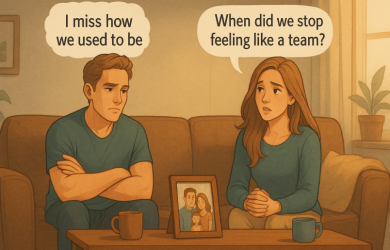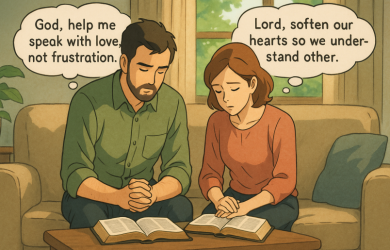11 Tips if You Don’t Want a Divorce but Your Spouse Does

Unlock Daily 30-Sec Tips for a Happier Relationship
👉 Subscribe FREEKey Takeaways
Marriage.com AI Quick Summary
“Can we talk? I think we need to consider a divorce,” Sarah says quietly, avoiding John’s gaze.
Shocked, John’s first instinct is to say, “No, I don’t want a divorce.” But the words freeze before they leave his mouth, tangled in a mix of fear and confusion.
What do you do when your spouse brings up divorce, but you’re not ready to give up on your marriage? This situation can leave you feeling isolated and desperate for actionable steps to mend what seems broken.
In this article, we explore practical steps you can take to address the issues in your relationship.
From communication strategies to counseling options, these insights aim to empower you to initiate healing and possibly turn the tide in your marriage.
Whether it leads to reconciliation or simply a clearer understanding of your partnership, these actions can profoundly impact your relationship’s path forward.
What if I don’t want a divorce: 10 tips that can help
Facing the possibility of divorce can be daunting, especially when you feel unprepared and reluctant to end your marriage. If you find yourself thinking, “I don’t want a divorce,” there are several steps you can take to address the situation and perhaps turn things around.
Here are detailed actions to consider, aimed at improving your relationship or coping more effectively.
1. Seek couples therapy
Couples therapy is particularly beneficial if you’re struggling with how to deal with divorce when you don’t want it. It provides a structured environment where both partners can explore deeper issues within their relationship under the guidance of a trained professional.
Clinical Social Worker Grady Shumway further says:
Professional guidance can provide a structured and supportive environment for addressing underlying issues, improving communication, and rebuilding trust, offering hope for reconciliation and strengthening the marital bond.
A therapist can help facilitate discussions that might be too difficult to tackle alone, offering tools and techniques to improve understanding and empathy between partners.
- Tip: Find a therapist who specializes in your specific issues (like communication or infidelity) and make sure they’re trained in approaches proven to help couples (like Emotionally Focused Therapy or The Gottman Method).
2. Improve communication
Effective communication is crucial, especially when expressing sentiments like “I don’t want a divorce.” This involves more than just talking about day-to-day activities; it requires both partners to share their feelings, fears, and desires openly.
Learning to communicate without blaming, judging, or getting defensive is crucial.
- Tip: Practice the “speaker-listener technique” where one person speaks without interruption, using “I” statements to express feelings, while the other listens and then repeats back what they heard to confirm understanding.
3. Spend quality time together
In the hustle of daily life, dedicating time to spend together can help reconnect you and your partner.
Whether it’s a date night or a shared hobby, these moments are crucial for maintaining the connection that might otherwise fade, offering a reminder of the mutual affection and shared experiences that form the foundation of your relationship.
- Tip: Schedule regular date nights that go beyond just dinner and a movie. Try new activities that can help you reconnect, like taking a dance class or going hiking, to inject fun and novelty back into your relationship.
4. Express appreciation and gratitude
Regular expressions of gratitude can transform the emotional climate of a marriage. Acknowledging the positive attributes and actions of your spouse reinforces the value of the relationship and your partner’s role in it.
Research shows that the simple expression of gratitude in a relationship can impact a relationship positively, by making partners feel appreciated, seen and loved.
Gratitude can reignite warmth and affection, making it easier to navigate how to accept divorce when you don’t want it, by maintaining a positive relationship regardless of the outcome.
- Tip: Start a gratitude journal specific to your relationship where you both write down things you appreciate about each other daily. Exchange the journals monthly to read each other’s entries.
5. Evaluate changes
Evaluating necessary changes involves a candid look at what both partners can do differently to enhance the relationship. This step is essential whether you’re trying to prevent a divorce or manage the dynamics of an inevitable separation.
Measuring change requires an honest assessment of one’s actions and their effects on the relationship, committing to genuine improvement and growth.
- Tip: Hold a weekly relationship check-in where you discuss what each of you can do in the coming week to meet the other’s needs more effectively. Keep the conversation constructive and solution-focused.
6. Establish common goals
Reconnecting with your partner on future aspirations can be pivotal in mending a strained relationship, especially if you find yourself thinking, “I don’t want a divorce.” Start by discussing what you both value and envision for your lives together.
Studies show that the interdependency of couples in fulfilling their goals together, plays a marked role in determining relationship satisfaction levels.
Aligning on these goals not only reinforces your shared path but also can reignite the teamwork and partnership aspect of your relationship.
- Tip: Create a vision board together that represents your shared goals and dreams. This can be a powerful visual reminder of your connected futures and can help align your daily actions with your long-term objectives.
7. Address unresolved conflicts
Often, lingering resentments from past disagreements can poison the well of a marriage. Tackling these head-on is crucial. Approach these conversations with a mindset of resolution rather than blame.
Both parties should have the opportunity to express their feelings and perspectives, and then collaboratively work on finding solutions or compromises.
- Tip: Use a timer during discussions about sensitive topics to ensure that both partners have equal time to speak without interruptions. This helps in managing emotional responses and ensures both voices are heard.
8. Educate yourself on relationships
Understanding relational dynamics can significantly benefit your marriage, especially during turbulent times. Consider investing time in relationship books, seminars, or online courses that offer advice on improving communication, intimacy, and conflict resolution.
Knowledge gained from these resources can provide practical tips and deeper insights into how to maintain a healthy relationship dynamic, a key aspect if you find yourself saying, “I don’t want a divorce.”
- Tip: Join a book club or an online community that focuses on relationship health. Engaging with others can provide additional support and insights, and motivate you to apply what you learn.
9. Consider temporary separation
While it may seem counterintuitive, taking a brief, agreed-upon break from each other can sometimes help couples appreciate what they have.
During this time apart, each person can reflect on their personal needs, feelings, and the aspects of the relationship that are most important to them.
According to Grady Shumway, a licensed mental health counselor:
You do not want to find yourself in the middle of a heated or fueled reaction. Allowing yourself space and time is always appropriate.
Giving each other space can lead to clearer thinking and renewed perspectives, which can be beneficial when you reconvene to decide the future of your relationship or, if necessary, how to accept a divorce you don’t want.
- Tip: Define clear rules and objectives for the separation period, such as working on personal growth or consulting individually with therapists, and maintain periodic check-ins to evaluate progress.
10. Legal consultation
If your spouse is persistent about divorce, it’s wise to consult with a legal professional to understand your rights and options. This step isn’t about gearing up for a battle but ensuring you are protected and informed about the potential outcomes.
A legal expert can provide guidance on financial arrangements, custody matters (if children are involved), and the overall divorce process, helping you to navigate this challenging time with confidence and clarity.
- Tip: Before meeting with a lawyer, prepare a list of questions and concerns about the legal process and your rights. Understanding the legal aspect thoroughly can reduce fears and misconceptions about the outcomes of a divorce.
5 reasons why your spouse might want a divorce
Divorce is a significant decision often contemplated when underlying marital issues become overwhelming. Understanding why one’s spouse might consider this option can help in addressing concerns proactively. Here are five reasons that might prompt thoughts of separation:
1. Communication breakdown
Effective communication is vital in marriage. When couples stop sharing their thoughts, feelings, and concerns openly, misunderstandings can escalate, leading to frustration and emotional distance.
Over time, this breakdown can make spouses feel isolated or neglected, pushing them towards considering divorce as they may see no other way to resolve their loneliness or unhappiness.
- Prevent this by: Schedule regular “check-in” conversations where both partners can freely express their thoughts and feelings. This routine helps maintain open lines of communication and prevents misunderstandings from building up.
2. Infidelity
Infidelity strikes at the heart of marital trust. When one partner steps outside the marriage, it not only introduces betrayal but also deeply wounds the other’s self-esteem and trust in the relationship. The aftermath of an affair often includes anger, sadness, and a profound sense of loss.
Recovering from such a breach can be difficult, and for some, divorce might seem the only option to move forward from the pain.
- Prevent this by: Cultivate transparency in your relationship. Share passwords and allow access to phones and social media as a gesture of trust. Regularly discuss boundaries and ensure both partners feel secure and valued.
3. Lack of intimacy
Intimacy is not just about physical closeness; it includes emotional connections and shared vulnerabilities. When these bonds weaken, partners may start to feel disconnected from each other. This disconnection can manifest as a lack of conversation, reduced sexual interest, and diminished affection.
Over time, without these intimate connections, spouses might begin to question their compatibility and happiness, leading them to think, “I don’t want a divorce, but I feel pushed away.”
- Prevent this by: Commit to regular date nights and moments for just the two of you, no matter how busy life gets. Prioritize affectionate touch and verbal expressions of love, which can strengthen emotional bonds and physical connection.
4. Divergent goals and values
As individuals grow, their personal ambitions, dreams, and values can evolve. If couples find themselves heading in different directions without a shared vision for the future, they might feel they are no longer a good match. This could be about career choices, family planning, or lifestyle preferences.
When such fundamental aspects of their lives are at odds, spouses might view divorce as a necessary step to pursue their own happiness and fulfillment.
- Prevent this by: Conduct yearly reviews of personal and shared goals. Discuss what each of you wants for the future and find common ground or compromises that align with both partners’ aspirations and values.
5. Constant conflict
Persistent unresolved conflicts can create a hostile and stressful home environment. When arguments become the norm rather than the exception, and resolutions seem out of reach, the emotional toll can become unbearable.
Living in such negativity can lead spouses to seek relief through divorce, considering it an escape from the ongoing strife and a chance to find peace and stability elsewhere. A spouse may lament, “I don’t want a divorce, but I can’t live like this.”
- Prevent this by: Learn and practice conflict resolution strategies. Focus on addressing issues constructively without blame. Consider professional help like a marriage counselor if conflicts escalate beyond simple resolutions, to ensure both voices are heard and respected.
Questions to ask yourself if you don’t want a divorce but your spouse does
If you feel like divorce might be your only option despite not wanting it, asking yourself some introspective questions can provide clarity and potentially reveal alternative paths or solutions. Here are several questions to consider:
| Question | Reason |
| Have I communicated my feelings openly and honestly? | Reflect on your communication efforts to ensure all feelings and concerns have been expressed. This might reveal unaddressed issues or misunderstandings. |
| What have I done to try to improve the situation? | Assess your actions, like seeking counseling or improving dialogue, to see if more can be attempted to resolve issues. |
| Can I identify the root causes of our problems? | Identifying core issues allows for targeted solutions, which can be more effective than addressing symptoms alone. |
| What are the potential consequences of divorce for me and others involved? | Consider the broad impacts, both emotional and financial, on everyone involved, which could influence your decision. |
| Is there still love and respect in our relationship? | Evaluate if foundational emotions like love and respect remain, as they are crucial for rebuilding and recovery. |
| What am I afraid of if we stay together? If we part ways? | Understanding your fears related to both scenarios helps clarify what is truly at stake and guides your decision-making. |
| Have we exhausted all possible solutions, such as professional help? | Review whether all avenues, including professional advice, have been pursued to address the marital challenges. |
These questions are designed to provoke deep thinking about your marriage and whether there might be alternatives to pursuing a divorce. They can help you make a more informed decision or open up new avenues for saving the relationship.
7 options to consider if your spouse wants a divorce but you don’t
When facing the painful prospect of divorce, especially when one partner is unwilling, it’s crucial to explore all possible options thoughtfully. The situation can be emotionally complex, but understanding your choices can help navigate this challenging time.
Here are some options you might consider if you find yourself thinking, “I don’t want a divorce,” but your spouse does:
1. Seek understanding
Initiate open, honest discussions to understand your spouse’s reasons for wanting a divorce. This can uncover underlying issues and provide an opportunity to address them directly, potentially opening pathways to reconciliation.
-
Helpful tip:
Actively listen without interrupting when your spouse explains their feelings, as understanding their perspective fully can pave the way for constructive solutions.
2. Counseling
Suggest engaging in marriage counseling or individual therapy. Professionals can mediate and provide strategies to improve communication and resolve conflicts, potentially salvaging the marriage. This approach can be crucial in figuring out how to deal with divorce when you don’t want it.
-
Helpful tip:
Choose a counselor or therapist who specializes in marital issues and is known for a balanced approach to ensure both sides feel supported and understood.
3. Temporary separation
Consider a trial separation to allow both partners time to reflect and evaluate their feelings independently. This space might help your spouse reassess their decision or give both clarity on what if I don’t want a divorce and how to proceed.
-
Helpful tip:
Define clear rules and objectives for the separation period, such as how often you will communicate and what each of you hopes to achieve to make it a constructive time.
4. Compromise and negotiation
Explore possible compromises or adjustments that might address your spouse’s concerns. Negotiating terms or changes in relationship dynamics can sometimes prevent a full separation or divorce.
-
Helpful tip:
Approach negotiations with an open mind and willingness to see things from your spouse’s perspective, which can foster empathy and lead to more effective compromise.
5. Legal consultation
Consulting with a lawyer can help you understand your legal rights and prepare for possible outcomes. Knowledge of the legal aspects can provide a foundation for making informed decisions about your future.
-
Helpful tip:
Even if you hope to avoid divorce, understanding your legal rights can empower you to make informed decisions and negotiate from a position of strength.
6. Self-care
Focus on maintaining your emotional and physical well-being. Engaging with supportive friends, family, or groups can provide comfort and guidance through this challenging period.
-
Helpful tip:
Engage in activities that strengthen your emotional resilience, such as exercise, hobbies, or therapy, to maintain your well-being during this stressful time.
7. Acceptance and planning
If divorce appears inevitable, begin planning for life post-divorce. This involves both emotional preparation and practical considerations, like finances and living arrangements, to ensure a smoother transition.
-
Helpful tip:
Begin to visualize and plan for a positive future, regardless of the outcome, which can help reduce the fear and uncertainty of what lies ahead.
How to accept divorce when you don’t want it: 9 steps
Accepting a divorce you don’t want can be a deeply personal and challenging journey. It’s important to navigate this process with care, focusing on healing and rebuilding your life.
Here are some steps to consider if you’re wondering how to accept divorce when you don’t want it, ensuring you emerge stronger and more resilient.
Step 1: Allow yourself to grieve
Recognize that it’s normal to feel a range of emotions such as sadness, anger, confusion, or relief. Allow yourself time to grieve the loss of the relationship, acknowledging these feelings as part of the healing process.
- Try this: It’s beneficial to keep a journal where emotions and thoughts can be expressed freely. This practice can be a therapeutic outlet, allowing for a private space to process and reflect.
Step 2: Seek support
Lean on friends, family, or a support group who understand what you’re going through. Consider professional help like a therapist who can provide guidance and coping strategies during this difficult time, helping you learn how to survive a divorce you don’t want.
- Try this: Joining online forums or local support groups where others share similar experiences can be incredibly supportive. It allows for a feeling of solidarity and understanding, which can be comforting during such a challenging time.
Step 3: Educate yourself
Understand the legal and financial aspects of divorce. Educating yourself will help you feel more in control and prepared for the changes ahead.
- Try this: Attending workshops or seminars about the legal aspects of divorce can empower someone with knowledge, reducing feelings of helplessness and confusion.
Step 4: Focus on self-care
Prioritize your physical and mental health. Engage in activities that nurture your well-being, such as exercise, hobbies, or meditation, which can help stabilize your mood and improve your outlook.
- Try this: Incorporating mindfulness or yoga can significantly aid in managing stress and maintaining emotional balance. These practices offer a refuge for calming the mind and strengthening resilience.
Step 5: Set new goals
Rediscover personal interests or goals that were sidelined during your marriage. Setting new goals can provide a sense of direction and purpose, helping to shift your focus toward the future.
- Try this: Setting small, manageable goals and acknowledging each achievement can provide a sense of progress and control, which is crucial during times of upheaval.
Step 6: Create a new routine
Establish a new daily routine to regain a sense of normalcy and structure in your life. This can help alleviate feelings of loss and confusion, providing stability during times of change.
- Try this: Introducing a new hobby or activity can bring a fresh sense of excitement and purpose, helping to redirect energy and focus during this transitional period.
Step 7: Embrace change
Gradually begin to accept that change is part of life. Embracing change can open up opportunities for personal growth and new experiences.
- Try this: Recognizing the potential for personal growth and new opportunities can help shift the perspective towards the positive aspects of change, fostering a sense of hope and possibility.
To learn more about the signs of personal growth and development, watch this video:
Step 8: Reflect on lessons learned
Consider what you can learn from the relationship and the divorce process. Reflecting on these lessons can lead to personal growth and better future relationships.
- Try this: Discussing one’s experiences and the lessons learned with a trusted friend or mentor can offer new insights and reinforce a supportive network.
Step 9: Plan for the future
Start planning for your life post-divorce. This includes considering changes in living arrangements, finances, and lifestyle. Planning helps create a roadmap for your new life.
- Try this: Using visual planning tools like vision boards can help clarify and organize thoughts about the future, making it feel more tangible and less daunting.
Step 10: Give it time
Accept that adjustment takes time. Be patient with yourself and recognize that moving on is a gradual process and not an overnight change.
- Try this: Regular check-ins on one’s emotional well-being and adjustments to coping strategies can be beneficial. This helps in acknowledging the healing process and adjusting the approach as needed.
Final thoughts
It’s always possible to introduce positive changes in our lives, changes that can transform our relationships for the better. The decision to stay or leave in a marriage is deeply personal and significantly influenced by the actions of those involved.
Sometimes, behaviors that undermine one relationship might go unnoticed until they disrupt another.
Recognizing these patterns and working to improve oneself can lead to better communication and stronger connections with your current or future partners.
If you find yourself facing a divorce that you didn’t want, it can feel like a door has closed forever. However, it’s important to recognize that this new beginning could lead to personal growth and happiness. Embracing this change might not be easy, but it can be a step toward a fulfilling future.
 Tips
Tips
Write your tip or submit a video tip
All tips are reviewed before the publishing.
Share this article on
Want to have a happier, healthier marriage?
If you feel disconnected or frustrated about the state of your marriage but want to avoid separation and/or divorce, the marriage.com course meant for married couples is an excellent resource to help you overcome the most challenging aspects of being married.
Related Quizzes
Unlock Daily 30-Sec Tips for a Happier, Healthier Relationship
👉 Subscribe FREE on YouTube We'd love your feedback!
We'd love your feedback!
 Expert Q&A
Expert Q&A
Ask your question related to this topic & get the support you deserve from experts.


















 Thanks for your feedback!
Thanks for your feedback!